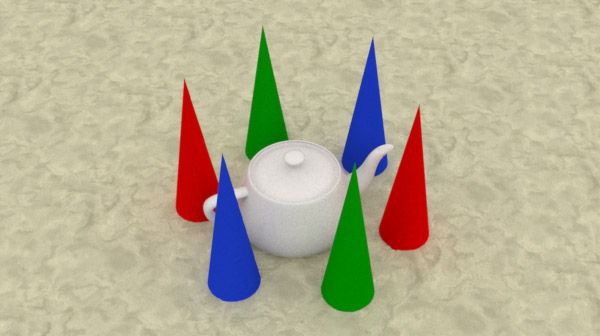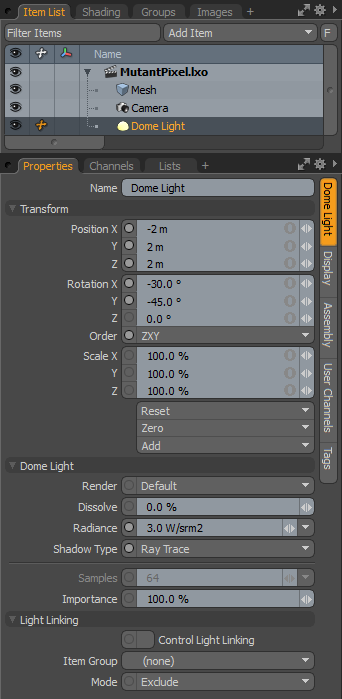Dome Light
The Dome Light creates a virtual dome of lights around the scene producing a flat, even illumination over surfaces similar to photos taken on an overcast day. Dome lights have often been used to simulate Global Illumination; however, with the Modo rendering engine, Global Illumination is just as fast, if not faster, than dome lights and generally yields more pleasing results.

This light has Position and Rotation controls as well as Radiance, Shadow Type, and Samples.
Note: There is no size or scale value as the dome always scales itself to encompass the entire scene, regardless of size. To control the light's color, shadow color, and other material-related properties, refer to the Light Material topic.

• Name - this data field displays the current item name. You can easily change it by clicking within the field and typing the new name.
The following Transform options are available for the Dome Light:
• Position - allows you to numerically position the light item in XYZ space.
• Rotation - allows you to numerically set the rotation of the light item.
• Order - allows you to set the order that the rotations are applied to the light item. Changing the order that rotations are applied can sometimes help to reduce or eliminate "gimbal lock".
• Scale - allows you to numerically set the size of the light item. This scale transform is a multiplier of the Height and Width options.
• Reset - resets the selected transform values to (0,0,0) returning the items back to their default state.
• Zero - resets the chosen transform property values to '0', leaving the Center position and Mesh position intact. This is done by adding an additional transform item to the Mesh Item's channels with an inverted version of the current values. This is useful to allow, for example, a joint to have a base value of 0,0,0 but still be located away from the World Origin.
• Add - adds additional Transform items to the associated item or, if they do not yet exist, it simply adds them. Transform items are the channel groups that store the actual transform values, controlling any item's position, rotation, and/or scale. You can add as many transform items as you want for any transform property desired. Adding additional Transform items produces an additive effect where each transform group is evaluated before the next, and so on. Additional item transforms are evaluated in their order in the Channels list, from the bottom upwards.
Note: It should be noted that by default, new items do not have any transform items associated with them (even though they are visible here within the Properties panel). This is useful as an optimization, as only the necessary transforms are created on an as-needed basis, reducing scene overhead.
There are several actions that add these base transform items. One is by simply transforming the target item with one of the various transform tools or by editing the values input fields. This action causes the particular transform item to be added automatically to the Channels viewport list. Due to this fact, you may need to specifically create item transforms when Referencing, because in order to override the channels in the master scene, they must first exist.
The following Dome Light options are available for the Dome Light:
• Render - allows you to select from three choices: when set to Default, you can enable/disable lights using the visibility function ![]() of the item list. When the light is visible, it contributes to the final rendered scene and, when invisible, it does not. On some instances you may prefer to fix this state, setting the light as On (enabled) or Off (disabled) regardless of visibility. Also useful for workflows that auto toggle visibility, saving you from manually enabling lights for test renders.
of the item list. When the light is visible, it contributes to the final rendered scene and, when invisible, it does not. On some instances you may prefer to fix this state, setting the light as On (enabled) or Off (disabled) regardless of visibility. Also useful for workflows that auto toggle visibility, saving you from manually enabling lights for test renders.
• Dissolve - when the Dissolve function is set to any value above 0%, the light's overall effect on the scene attenuate as the value increases. When set to 100%, the light's effect on the scene is completely disabled. This function provides a convenient way to dim a light's effect within a scene.
• Radiance - controls the intensity of the light and uses the standard physically-based unit of Watts per volumetric meter. As you would expect, increasing this value increases the amount of light coming from the Dome Light and decreasing the value reduces the light intensity. With dome lights, the area of light generated in the scene is very small and therefore large values are likely necessary to illuminate the scene how you would expect.
• Shadow Type - offers options between Ray Traced, None and Deep Shadow Maps. In situations where you want a light to cast a shadow, Ray Traced gives the most accurate results. The traditional hard edge of ray traced shadows can easily be softened using Spread Angle value in any light item. Deep Shadow Maps are useful for volumetric lights and fur rendering, where a great deal of calculations are required to produce shadows; producing similar results to ray traced shadows while reducing the number of calculations.
• Samples - when the Direct Illumination option is set above zero, the Samples value is grayed out as there is no need for you to adjust it. The number of samples are dynamically allocated using the adaptive light sampling method. This provides you a global control to adjust overall shading and shadow quality. When the Direct Illumination option is set to '0', this disables adaptive sampling and you can manually adjust this Samples value to control light and shadow quality per light.
As the size increases, additional samples are required to smooth out the resulting soft specular shading and soft edge shadows. If they appear grainy, increasing this sample setting is the most likely solution. The default value is a good starting point for balancing speed and quality. As the size increases or the resolution of the image increases you can drive this number higher to account for any grain that appears. Keep in mind that increasing the number of samples also increases render times.
• Importance - Modo uses an adaptive light sampling method to evaluate lighting in a scene. This option allows you to control illumination sampling using a single global value, producing better results in less time. In rare cases, where adaptive sampling isn't producing the desired outcome, an individual light's Importance value can be adjusted, acting as a multiplier to the lights evaluated importance. Changes in Importance are relative to other lights in the scene, influencing it one way or the other as more or less important, in effect increasing or decreasing its sample allocation from the total number of possible Light Samples, all while remaining fully unbiased.
The following Light Linking options are available for the Dome Light:
• Control Light Linking - illumination on a surface is generally controlled by the Shader item in the Shader Tree. Within the shader, it's possible to control a light's effect on a surface with Light Linking. As its name describes, it links the illumination affects of a group of lights to specific items or material groups. When the Control Light Linking option is enabled on a light item, it acts as an individual light-specific override to the shader, allowing you to Include or Exclude a specific light's illumination on a group of items.
• Item Group - determines the specific group of item layers in the scene that is affected by the Light Linking. The group needs to be defined in the Groups viewport panel. This can be done easily by selecting the target items while in Items mode and then, in the Groups palette, click the New Group button. Define a name for the group in the pop-up dialog and choose the From Selected Items option and click OK to accept. Once the group is defined, select the named group here.
• Mode - determines whether the light is Included, meaning it only affects the items in the specified item group, and Excluded by all other surfaces, meaning it is ignored by any items in the specified item group.
Sorry you didn't find this helpful
Why wasn't this helpful? (check all that apply)
Thanks for taking time to give us feedback.